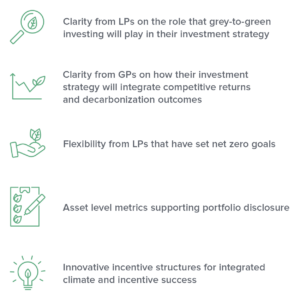In conversations with our members and other subject matter experts, we find that LPs’ participation is limited due to concerns around returns, metrics, and potential reputational risk. Accordingly, mutually reinforcing systems will be needed for the grey-to-green transition to gain traction. This includes transparency from LPs and GPs on their investment strategies, portfolio and asset-level disclosure from GPs, and innovative incentive structures.
Key Takeaways
Spurred in part by a growing LP focus on the climate transition, many of the largest global private market investors have set climate change goals and are mobilizing climate change funds. When it comes to investing in high-carbon assets, LPs have concerns:
- That the returns are commensurate with the risk.
- That high-carbon investing increases the carbon intensity of their portfolios.
- That the reputational and regulatory risks associated with investing in high-carbon assets pose additional complications.
As such, successful allocation for a grey-to-green transition will require LPs and GPs to establish mutually-reinforcing systems, with a focus on integrating climate and financial strategies. They will need:

The report provides several frameworks in support of these objectives, including:
- GP-LP conversation guide on grey-to-green investment opportunities (pg. 10)
- Asset-level metrics (pg. 12)
- Incentive structures that illustrate climate integration (pg. 13)
Private markets are well-positioned to lead the grey-to-green transition as they possess the skillset and tools required for its success. Together, LPs and GPs can set companies – and the world – on the path to a lower-carbon future.
Download Grey to Green: The Opportunity for Private Equity to Decarbonize Assets



